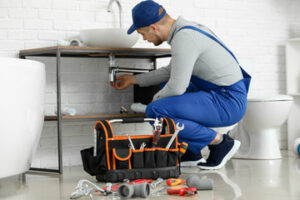Plumbing encompasses a broad range of activities, from installing water fixtures to maintaining drain lines. It’s important to understand how these systems work to ensure that your home or business has a safe, sustainable water supply.

The most basic concepts of plumbing include gravity, water seeking its own level, and a network of pipes that connect each fixture. These systems are regulated by both state and federal agencies to ensure safety and functionality. Visit https://www.plumbing-express.com/ to learn more.
When you turn on the faucet to wash your hands or flush the toilet, it’s easy to take for granted that you’re using a system that has been around for millennia. But the truth is that plumbing has actually come a long way since its inception.
Early plumbing developments were largely the result of ancient civilizations trying to manage their water supply and remove waste. It’s no secret that these early systems were not ideal — they often involved unsanitary conditions, such as raw sewage or standing water in homes and public buildings. But as people continued to develop their cities, they began focusing on creating better ways to provide clean drinking water and remove waste.
The first significant leap in plumbing came with the invention of copper pipes. This innovation was first implemented where residents were able to have clean water flowing into their homes. This was followed by the invention of aqueducts, which allowed for water to be transported over long distances while also managing waste. The Romans took this technology a step further by introducing public baths and sewer systems.
By the 19th century, we had reached a point where indoor plumbing became more commonplace. Sewer systems were put in place to deal with the growing amount of sewage that was being produced, and the first flushing toilets were developed.
These advancements helped to prevent the spread of disease and keep cities clean. However, it wasn’t until the 1930s that a set of standard plumbing codes was developed. These were created by a man named Dr. Hunter and were known as the BMS 65, BMS 66, and BMS 79 manuals.
The BMS 66 manual focused on water piping, while the other two manuals addressed sanitary sewers and drainage. These codes were a huge milestone and are still used today. They weren’t mandatory, as the federal government didn’t see it as their role to create a national code and instead opted to offer these documents as guidelines for municipalities to follow. Today, we have more advanced plumbing innovations like recirculating pumps, which save energy by not running water all the time and use water efficiently; plastic pipes, which were introduced during WWII as an alternative to metal; and showers that are accessible for people with disabilities.
Functions
Plumbing is the system of pipes, fixtures, and other apparatus that bring water into buildings and remove wastewater. Its functions include supplying clean water for use in washing, cooking, and drinking, and removing waste to ensure a hygienic environment. Plumbers install, repair, and maintain these systems. They also work with a variety of tools and materials, including copper, PVC, and PEX pipes. Plumbers must comply with building codes and regulations to guarantee safety and functionality.
Plumbers often work at height or in cramped conditions, making them susceptible to injuries from falls and other workplace hazards. They may also be exposed to toxic chemicals, bacteria, and sewage. Regular health and safety training can reduce these risks, as can maintaining a proper workstation setup and following proper cleaning procedures. Plumbing work can also lead to repetitive strain injury (RSI), which can affect the forearms, wrists, hands, neck, and shoulders. This can lead to severe pain and disability, which is why it’s important to practice proper ergonomics when working on a job site.
Key Performance Indicators (KPIs) are crucial metrics that help you monitor and analyze your business’s performance. They help you make data-driven decisions that drive growth and profitability for your plumbing business. Below are some of the top KPIs to consider:
Dispatch KPIs
Effective dispatch management is essential for the success of your plumbing business. It involves tracking customer information, assigning jobs, and communicating with technicians. Using a competent Customer Relationship Management (CRM) system can simplify these tasks and improve efficiency.
Pipes and Fittings
Despite their surface-level similarities, plumbing and piping have distinct functions. While plumbing brings water into and provides drainage from facilities, process piping moves gases, chemicals, and other fluids between locations during manufacturing processes.
Plumbing supplies water for various uses in a home, including sinks, bathtubs, toilets, and showers. It is carried from the main supply lines by valves to end-use points, such as faucets and water heaters. The waste from these fixtures is then drained into the sewer or septic tank via drain lines. Valves, such as gate valves, ball valves, and globe valves, regulate the flow and pressure of water in pipes. They allow for the isolation of specific sections of a plumbing network, making it easier to carry out repairs and maintenance.
Materials
There are many different materials that make up plumbing systems. Choosing the right one is important because it could impact how long they last, how much maintenance they require and how safe they are to use. These pipes are used to deliver freshwater and sewage waste, so they must be strong enough to withstand pressures and avoid leaking. The best choice is a sturdy material that can be easily repaired or replaced, like metal or plastic.
Copper and PVC pipes are the most common materials for plumbing systems. These durable pipes are both rust-resistant and strong enough to handle water pressures. They are also easy to work with and cost less than other pipe options, making them a great choice for do-it-yourselfers. However, they are not ideal for homes with hard or acidic water because they can corrode over time.
Another option for piping is PEX, which stands for cross-linked polyethylene. This type of plastic is tolerant against rust and corrosion, making it ideal for freshwater lines. It is also flexible and can bend around curves, which makes it easier for plumbers to work with than rigid pipes. However, it cannot withstand high temperatures, so it’s not the best choice for hot water lines.
Other types of piping include steel, cast iron and galvanized steel. These are rarely used for new plumbing installations, but you might find them in older homes. Galvanized pipes have a zinc coating that stalls rust, but they are still susceptible to mineral buildup and corrosion. Steel and cast iron pipes are also prone to bursting and cracking under stress, which can lead to expensive repairs.
Silicone is another common plumbing material that can be used in both fresh and drain piping. This synthetic rubber is soft enough to stretch and manipulate into tight spaces but tough enough to withstand frequent usage. It’s also non-toxic, so it won’t leach chemicals into your water. However, it is not suitable for freezing temperatures and can rupture under pressure. In addition, it may not be effective against certain bacteria and chemicals.
Regulations
The plumbing codes establish the minimum requirements that construction professionals must follow to ensure safety standards and maintain public health measures. These guidelines are updated periodically, so it is important for construction professionals to have access to the most recent version of the code in order to comply with all applicable regulations. The scope of these regulations includes everything from preventing damage to walls through fixture usage to clarifying rules surrounding condensate drains.
Each length of pipe, fitting or device utilized in a plumbing system shall be identified with the name of its manufacturer and any marking required by the referenced standards or by the manufacturer’s installation instructions. Any such material not conforming to the minimum provisions of this chapter shall be in violation of this code.
All pipes and fixtures in contact with water shall be thoroughly cleaned after installation, and all connections with the sewer system shall be made and tested. The plumber shall make full and complete returns to the department of any work done, and he shall keep an account of all materials furnished and of all moneys received for such work. He shall also notify the commissioner of any leaks or failure of connections within two (2) days after such works are completed.
A person who engages in the trade or business of plumbing shall register with and be licensed by the board of examiners, and the license shall be subject to renewal annually between the first (1st) and tenth (10th) day of January of each year. The board of examiners shall have the power to inspect all plumbing work, and to require the removal or alteration or repair of any unregistered work, and to order a re-inspection of any work which has not been satisfactorily completed or is unsafe.
In addition, the code requires that each house be provided with a main service pipe into the cellar. All service lines shall be of the copper type, and each main line in the cellar shall be provided with a stopcock and waste. Where possible, each main pipe shall be introduced into the cellar before it is connected to any branch pipes, and each branch pipe into the cellar shall be supplied with a shut off valve in the cellar. Whenever possible, plumbing systems shall not be located in elevator shafts; however, any plumbing system not related to elevator machinery may be installed at the base of an elevator shaft.
